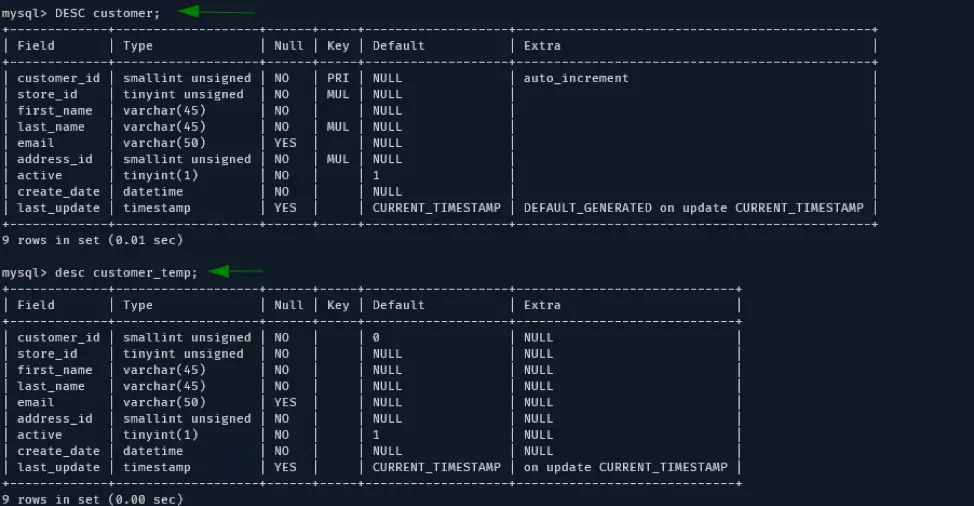
Even your temporary table will not exist. Now, if you will log out of the MySQL session and then you will issue a SELECT command, then you will find no data available in the database. When you issue a SHOW TABLES command, then your temporary table would not be listed out in the list. | product_name | total_sales | avg_unit_price | total_units_sold | > (product_name, total_sales, avg_unit_price, total_units_sold) >, total_units_sold INT UNSIGNED NOT NULL DEFAULT 0 >, avg_unit_price DECIMAL(7,2) NOT NULL DEFAULT 0.00 >, total_sales DECIMAL(12,2) NOT NULL DEFAULT 0.00 Mysql> CREATE TEMPORARY TABLE SalesSummary (

#Create temporary table insert into mysql code
The same code can be used in PHP scripts using the mysqli_query() function.

The following program is an example showing you the usage of the temporary table. If you are connected to the MySQL database server through the MySQL client program, then the temporary table will exist until you close the client or manually destroy the table. If you run the code in a PHP script, the temporary table will be destroyed automatically when the script finishes executing. What are Temporary Tables?Īs stated earlier, temporary tables will only last as long as the session is alive. The most important thing that should be known for temporary tables is that they will be deleted when the current client session terminates.
#Create temporary table insert into mysql how to
In this tutorial, you have learned about MySQL BIT data type and how to use it to store BIT data in a table.The temporary tables could be very useful in some cases to keep temporary data. To display it correctly, you can use the LPAD function: SELECT To view the data you use the same query as above: SELECTĪs you can see, MySQL removed the leading zeros prior to returning the result. However, the 111100 value will also work because MySQL will pad one zero to the left. Suppose the first day of the second week is off, you can insert 01111100 into the days column. If you insert a value to a BIT(n) column that is less than n bits long, MySQL will pad zeros on the left of the bit value. To represent it as bit values, you use the BIN function: SELECT The following query retrieves data from the working_calendar table: SELECTĪs you see, the bit value in the days column is converted into an integer. Suppose that Saturday and Friday of the first week of 2017 are not the working days, you can insert a row into the working_calendars table: INSERT INTO working_calendars(y,w, days) The values in column days indicate whether the day is a working day or day off i.e., 1: working day and 0: day off. The following statement creates a new table named working_calendars that has the days column is BIT(7): CREATE TABLE working_calendars( The following is an invalid bit literal value: 0B'1000'īy default the character set of a bit-value literal is the binary string as follows: SELECT CHARSET(B ') - binaryĬode language: SQL (Structured Query Language) ( sql ) MySQL BIT examples

However, the leading 0b is case-sensitive, therefore, you cannot use 0B. The leading b can be written as B, for example: b01 To specify a bit value literal, you use b'val' or 0bval notation, which val is a binary value that contains only 0 and 1. Therefore the following statements are equivalent: column_name BIT(1) Ĭode language: SQL (Structured Query Language) ( sql ) The default value of n is 1 if you skip it. Here is the syntax: BIT(n) Code language: SQL (Structured Query Language) ( sql ) The BIT type that allows you to store bit values. Summary: in this tutorial, you will learn about MySQL BIT data type and how to use it to store BIT data in a table.


 0 kommentar(er)
0 kommentar(er)
